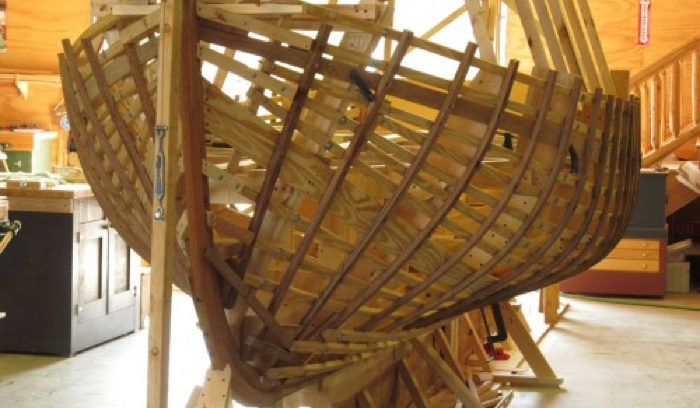
Katie – SOLD

Completed Project
Katie was designed for use as a daysailer – weekender. She has a large comfortable cockpit with a small cabin with two berths. The ballast keel with centerboard allows venturing into some shallow areas.
Price: $25,000 SOLD
PROJECT SCOPE
Katie is a 20’ Gaff Rigged Pocket Cruiser which was designed for personal use by the well-known and respected modern day boat designer/builder Harry Bryan. She has a large comfortable cockpit and a small cabin with two births. Katie was one of the featured boats in WoodenBoat magazine’s 2010 edition of “Small Boats”.
Katie was inspired the legendary N.G. Herreshoff’s Buzzard Bay12½ (LWL:12-6″, LOA: 15’-8”) and her bigger cousin the Fish Class Sloop (LWL:16’, LOA:20’-9”) that are commonly seen on the New England Coastal waters. One can clearly see the unmistakable characteristics of the 12½ and the Fish Class sloop in Katie’s lines, transom, and sheer strake. Harry’s design is also influenced by Joel White’s Flatfish. Flatfish is Joel’s shoal draft adaption of the Fish Class Sloop and is designed with a retractable center board.
For Harry’s purposes on Katie, he designed a level ballast keel for venturing into shallow waters. In addition to sailing in shallow (Draft is just 1’-6”) water, the level keel and retractable center board will also allow Katie to sit flat while moored and grounded during low tide.
Another benefit of the level keel and retractable center board design is that it allows for easier towing and launching from a trailer. And because she sits low on a trailer directly on her keel, you could even camp on Katie while traveling on the road towing her to a distant port.
To allow for a cabin, Harry increased freeboard and at the same time left a low cabin profile that results in a small, but comfortable cabin with minimal overnight accommodations for two with full headroom when seated. There are storage shelves and storage trunk space.
Katie is gaffed rigged with a mainsail and jib rigged to a bow sprit. The boom is high enough to allow for great visibility from the cockpit and minus the hazard of being hit in the head by a swinging boom. The mast, at 65 pounds, can be stepped up by two people.
Harry reports that Katie sails fast and easy.
STUDENT LEARNING EXPERIENCE
As part of the Traditional Boat Building session, students will work on two different boats to learn advanced wooden boat building skills. Because there is not enough time in the school year to build a single advanced wooden boat to completion, staggering the building process between two different wooden boats is an alternative. Having two different advanced wooden boat under construction at the same time exposes the student to many advanced boat building skills in the time allotted for the Traditional Boat Building session.
Each year students will loft and construct the backbone of an advanced wooden boat and plank it. Then it will be left to the next years class to complete it. At the same time the class will pick up on the advanced wooden boat project started by the previous years class and build it to completion.
Katie, is an excellent choice for an advanced wooden boat building project. The first year class of 2013 lofted, framed, and planked her. And the first year class of 2014 will complete her. Students will expand their lofting skills learned in the previous session Classic Wood Working and Small Boat Building, and will learn to loft the developments (rabbet, stem sections, transom expansion, deck camber, shelf and clamp expansion) to properly shape the transom, stem and deck.
Students will then learn how to build Katie’s backbone consisting of the keel, stem, and transom. They will construct and install the molds which will be framed with ribbands. Then they will go on to steam bending the oak frames that get shaped around the ribbands.
Katie, will be carvel planked, so students will learn how to line off, spile, shape, hollow, round, and bevel carvel planks to fit around the oak frames of the boat and butt up against one-another edge-to-edge. Then students will seal tight the planks by caulking the seams with cotton.
Katie’s upper work’s consist of a deck and cabin, so students will learn how to construct a deck beginning with the shelf and clamp, and then go on to the deck beams and carlins, along with framing the cabin. Then they will lay the deck itself and enclose the cabin.
Students will learn spar making skills beginning with learning how to develop the taper lines for spars and then go on to shape them using hand tools.
In the final stages students will learn to “fit out” the boat in installing all the necessary hardware. Second-year students will apply yacht joinery skills to complete the interior of the cabin.
Finally the students will learn finishing skills beginning with fairing the hull, preparing for topsides paint, bottom paint, and varnish, and then applying the various finishes.
In the building of Katie, students will learn team work. It has been said, “To work with someone is to know him; to build a boat with him is to know him well.“ And so it goes at GLBBS. The goal is to have Katie ready for launching on graduation day.
PARTICULARS
- LOA: 20′
- Beam: 7′
- Draft: 20″
- Displacement: 2400 lbs
- Power: optional electric outboard motor
- Capacity: 2 to 6 adults day sailing
- Sail Area: 261 sq ft
- Sailing Rig: Gaff
DESIGNER
- Name: Harry Bryan
- Website: www.harrybryan.com
REFERENCES
CONSTRUCTION
- Backbone: All White Oak with Yellow Cedar Apron
- Frames: Steam Bent White Oak
- Transom: PortOrford Cedar
- Planking: Cypress




